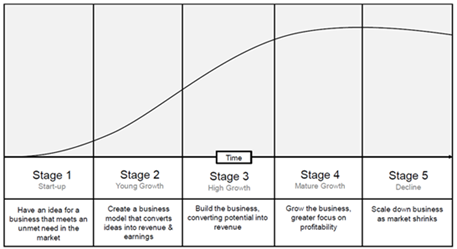We’re often asked where we find good companies. What is usually meant by this is where, in the economy, do we find good companies. But there is another way to think about the question, which examines the ‘where’ not in terms of economic sectors, but rather the company’s lifecycle.
S is for Sigmoid
The starting point is to identify the different lifecycle stages and examine the attributes that businesses demonstrate at each stage. These stages are broken down on the following chart and overlaid with an s-curve (or sigmoid curve) to illustrate the growth and the level of risk in each stage.
Figure 1: The company lifecycle

Source: Seilern. For indicative purposes
At the earliest Start-up stage, the business is vulnerable. It may exist purely as an idea, scribbled on a napkin, or as a loss-making business that’s investing heavily in customer acquisition. Risk is high: 75 per cent of start-ups will not see their 15th birthday, and 90 per cent will not reach a mature stage of consistent profitability. Survival is exceptionally difficult. This is not a journey to take lightly or alone – almost all start-ups are financed by borrowing or giving away a stake in the business.
Investing in start-ups requires imagination and faith. It is best left to venture capitalists.
The next stage is Exponential Growth, where the goal is to grow quickly or, in the words of LinkedIn Founder Reed Hoffman, to ‘blitzscale’. These companies enjoy exponential growth and often see repeated and rapid doubling of their business. For them, the most important factor is the continuity of growth. Momentum and first-mover advantages are important; profitability is often a secondary concern.
This poses several problems. Firstly, it is hard to know what the future earnings profile of the business will look like. Secondly, it is impossible to value the business on a traditional profitability metric because there isn’t one, despite the inventive metrics conjured up by business analysts.
Investing in exponential growth businesses is like picking your racehorse for speed, before you’ve seen it jump a fence. Execution risks are high, and the breadth of outcomes (both upside and downside) is wide. It is a high-risk, high-return strategy.
Once the business has run the gauntlet of young growth, established a viable network and achieved the first benefits of scale, it reaches the High Growth phase. Here, sales are increasing, but the rate has declined from the dizzying prior stage. The company has proved its business model and cracked the formula for profitable growth. The strategic direction now shifts from pure growth to scaling the enterprise.
Most of our investments fall into this category and for good reason – growth is high and has proven sustainable. These businesses are the very definition of Quality Growth investing.
In the next Mature Growth stage, growth moderates, as the business settles into its strong competitive position, and margins expand. Towards the end of this stage, as the market becomes saturated or old, growth slows and the focus shifts from the top line to profits, often with disastrous consequences.
For companies here, a large improvement in profitability is not a welcome development but a sign that the business is squeezing the last drops from a slowing market. For the quality growth investor, it’s a signal that the business is approaching ex-growth and risks a material re-rating.
The last stage is Managed Decline. For these companies, sales growth has disappeared or gone negative. Their excellent profitability has attracted fierce competition, while business inertia has led to abandonment by capital markets, driving the stock price lower. This is the point in the lifecycle when many value investors invest, searching for businesses where they believe that the market has been unfairly harsh. This is a high-risk strategy. While value may be visible, the investor needs a catalyst to unlock that value.
R is for Risk
The reason the quality growth investor spends much time in the high-growth and mature-growth stages of a business is to manage risk. In a company’s early stages, there are significant uncertainties surrounding its viability or ability to generate consistent profitable growth. At the other end of the lifecycle, questions around the viability of the business arise again as it grapples with decline.
The quality growth investor is instead looking for businesses that can demonstrate growth in a sustainable and predictable way, and where the distribution of outcomes is narrowed to reflect the lower upside potential and lower downside risk.
MJ Faherty,
26th February 2021
1Of course, there is a great degree of overlap between the different stages and some stages last for much longer than others but as a generalised tool, the S-curve is very useful.
2Where the proportional increase in quantity is constant over time.
Le présent document est une communication marketing / promotion financière destinée à des fins d’information uniquement et ne constitue en aucun cas un conseil en matière d’investissement. Toutes les prévisions, opinions, objectifs, stratégies, perspectives et/ou estimations et attentes ou autres commentaires non historiques contenus dans le présent document ou exprimés dans ce document sont basés sur les prévisions, opinions et/ou estimations et attentes actuelles uniquement, et sont considérés comme des « énoncés prospectifs » . Les énoncés prospectifs sont assujettis à des risques et à des incertitudes qui peuvent faire en sorte que les résultats futurs réels soient différents des attentes.
Il ne s’agit en aucun cas d’une recommandation, d’une offre ou d’une sollicitation d’achat ou de vente d’un produit financier. Le contenu ne prétend pas fournir des conseils comptables, juridiques ou fiscaux et ne doit pas être considéré comme tel. Son contenu, y compris les sources de données externes, est considéré comme fiable, mais ne fait l’objet d’aucune assurance ou garantie. Aucune responsabilité ou obligation ne sera acceptée pour modifier, corriger ou mettre à jour toute information dans le présent document.
Veuillez noter que les performances passées ne doivent pas être considérées comme une indication des performances futures. La valeur de tout investissement et/ou instrument financier inclus dans ce site Web et les revenus qui en découlent peuvent fluctuer et les investisseurs risquez de pas récupérer le montant initialement investi. En outre, les fluctuations des devises peuvent également entraîner une hausse ou une baisse de la valeur des investissements.
Ces informations ne sont pas destinées à être utilisées par des ressortissants des États-Unis. Elles peuvent être utilisées par des succursales ou des agences de banques ou de compagnies d’assurance organisées et/ou réglementées par la législation fédérale ou étatique des États-Unis, agissant pour le compte de particuliers non américains ou distribuant des produits à ces derniers. Il est interdit de diffuser ce document auprès des clients de ces succursales ou agences ou du grand public.
Recevez les dernières informations et événements directement dans votre boîte de réception
« * » indique les champs nécessaires





